Mark Kostabi, artist and composer, was born in Los Angeles in 1960, to Estonian parents. He studied drawing and painting at California State University, Fullerton. In 1982, he moved to New York, where he also frequented Andy Warhol’s Factory, emerging in 1984 as a leading figure in the East Village art scene. He positioned himself as a critic of the system, publishing a series of self-interviews reflecting on the degenerative aspects of contemporary art.

Rome, Mark Kostabi at work in his studio. Photo by Greesi Desiree Langovits
Since 1987, he began exhibiting in renowned galleries across the United States, Japan, Germany, and Australia. He gained recognition in the specialized press after founding Kostabi World in Manhattan in 1988, in all respects his ideal artist’s atelier, a modern environment but at the same time almost a medieval one, with numerous assistants and suggestions from friends and visitors. In 1990, Kostabi’s work started gaining recognition also in Italy, leading him to take a second residence in Rome in 1996, dividing his life between Rome and the United States. Kostabi produced a television show, “The Kostabi Show”, where famous critics and celebrities from the entertainment world competed in assigning titles to his paintings. From 2000 to 2010, he wrote notes and advise for artists (“Ask Mark Kostabi”) for Artnet.com.
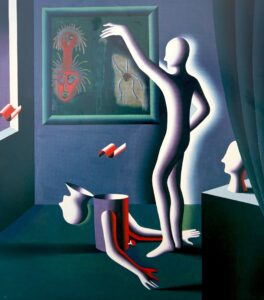
Mark Kostabi “Litmus Test” 1987, oil on canvas, 68 x 60 inches. Ph courtesy Kostabi World, New York
He designed album covers for Guns N’ Roses (Use your Illusion), the Ramones (Adios Amigos), Jimmy Scott (Holding Back The Years), Seether (Holding Onto Strings Better Left to Fry), and various objects including Swatch watches, Bloomingdale’s handbags, Alessi vases, Rosenthal cups, and a Giro d’Italia pink jersey. Kostabi is also known for collaborating or producing works in collaboration with internationally renowned artists such as Enzo Cucchi, Arman, Tadanori Yokoo, Enrico Baj, Paul Kostabi, and Tony Esposito. Moreover, Kostabi has performed numerous concerts, both as a soloist and with stars like Ornette Coleman, Jerry Marotta, Tony Levin, Tony Esposito, Greesi Desiree Langovits, Paul Kostabi, and Gene Pritsker. His compositions have been performed by Rein Rannap, Kristjan Jarvi, Maano Manni, Delilah Gutman, and the Estonian National Symphony Orchestra. His CDs include titles such as I Did It Steinway, Songs for Sumera, New Alliance and Kostabeat and Grace Notes. Mark Kostabi has also been the subject of numerous documentaries and films, including Bottom Line: The Kostabi Phenomenon directed by Peter Bach, Con Artist directed by Michael Sladek, Jedermann directed by Paul Tschinkel, and Full Circle: The Kostabi Story directed by Sabrina Digregorio. He is one of the four protagonists of the film My Italy, directed by Bruno Colella, with a cameo appearance by Achille Bonito Oliva, released in cinemas in 2017.
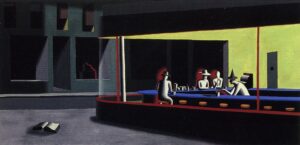
Mark Kostabi “Greenwich ave.” 1986, oil on canvas, 89.5 x 198 inches. Ph courtesy Kostabi World, New York
Extensive retrospectives on the work of this great master of contemporary painting were held at the Mitsukoshi Museum in Tokyo (1992) and the Art Museum of Estonia in Tallinn (1998). Vittorio Sgarbi curated an exhibition of 150 paintings by Kostabi at the Chiostro del Bramante in Rome in 2006. Kostabi’s works are permanently present in over 60 museums and collections, including the Museum of Modern Art (New York), the Metropolitan Museum of Art (New York), the Guggenheim Museum (New York), the Brooklyn Museum (New York), the National Gallery in Washington D.C., the Corcoran Gallery of Art, the Museum of Contemporary Art in Los Angeles, the Galleria Nazionale d’arte moderna in Rome, and the Groninger Museum in the Netherlands. His permanent public works include a mural for the Palazzo dei Priori in Arezzo, Italy, a bronze sculpture for the main square of San Benedetto del Tronto, and the bronze portrait of Pope John Paul II in Velletri.
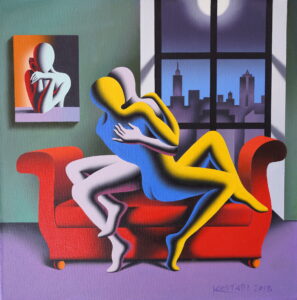
Mark Kostabi “Moonlight Encounter” 2018, oil on canvas, 50 x 50 cm. Ph courtesy Kostabi World, New York
Kostabi’s profile has been featured on “Eye to Eye” with Connie Chung, “A Current Affair, Nightwatch” (with Charlie Rose), “The Oprah Winfrey Show”, “Lifestyles of the Rich and Famous”, “Nonsolomoda”, West 57th, CNN, MTV, and numerous television channels in Europe and Japan. Among the many volumes published on Kostabi’s work are Sadness Because the Video Rental Store Was Closed, Kostabi: The Early Years, Conversations with Kostabi, The Rhythm of Inspiration, Mark Kostabi and the East Village Scene 1983-1987, and Mark Kostabi in the 21st Century. Juliet art magazine has featured him in various articles and on two covers. A catalog on his work will be published in the coming months and will be presented at Arte Fiera 2025.
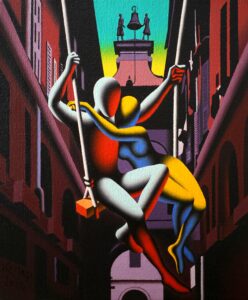
Mark Kostabi “Daydreams and Echoes” 2018, oil on canvas, 30 x 25 cm. Ph courtesy Kostabi World, New York
Roberto Vidali: Mark, you were one of the protagonists of the East Village; what do you remember of those fabulous 1980s?
Mark Kostabi: Hundreds of colorful, energetic art openings at small, often artist-run galleries in the East Village, with crowds spilling into the streets and rooftop parties frequented by hundreds of colorful artists, writers, poets, musicians and eager collectors. I recall frequent visits to Gem Spa (the most popular magazine and newspaper store at the time, now closed) to see if my name was in the paper. SoHo was much more established and upscale. All of us East Village artists dreamed of showing in a SoHo gallery and when it finally happened to some of us, it felt like an award, and was a big ego-boost. It was always exciting for me when Andy Warhol visited the East Village or SoHo galleries but some “too cool for school” East Village artists pretended not to notice. I’m sure they regret that now.
In 1988, you founded Kostabi World; can you briefly explain the concept behind this brand?
I was getting abundant press, for being open about using a lot of assistants to execute my paintings, to the point where it became a media performance piece. Having been raised not far from Disneyland in California I decided to name my studio in the spirit of Walt Disney, but Kostabi Land seemed too small — hence Kostabi World.
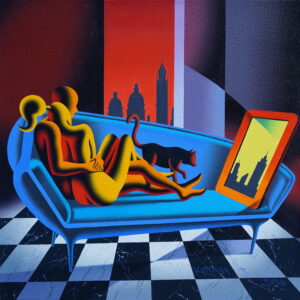
Mark Kostabi “After That” 2018, oil on canvas, 50 x 50 cm. Ph courtesy Kostabi World, New York
The Kostabian figure, devoid of physiognomic traits, is typical of all your paintings. Can you tell us about this choice?
It’s the result of my desire to have a universal visual language that transcends racial and national barriers, where everyone can read their own narrative into the paintings.
Do you think it would be correct to define yourself as a media painter?
Yes, my painting is a product of the media — my images are about the media — and I mediate between my images and my image.
How does music blend with your painting work?
I’ve been a visual artist since age 6 and a pianist since age 12. Both my parents were musicians and my mother was a professional piano teacher. Since 12 I’ve always alternated and combined the two activities. Except when I first moved to New York in 1982, I temporarily stopped music so I could focus 100% on becoming a successful artist, where I had a head start. Around 1985, as soon as I started making comfortably more money than I needed to pay the rent, the first expensive thing I bought was a 6 feet Steinway piano and I resumed my career also as a composer and pianist.
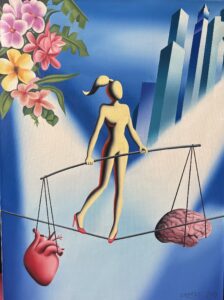
Mark Kostabi “Determination” 2019, oil on canvas, 80 x 60 cm. Ph courtesy Kostabi World, New York
Who are the authors of the past you admire the most?
Caravaggio, Raphael, Leonardo, Bernini, de Chirico and Warhol.
Now you have opened a second studio in Rome; is this a sign of further rooting in Italy?
It’s a sign that I wanted a home/studio in a quieter, more peaceful neighborhood in Rome, compared to the colorful but chaotic Piazza Vittorio. So I bought a “villino” in Monteverde Vecchio where I can host residential concerts and parties as I wish: this is building all to myself, where I didn’t need to bow down to neighbor’s needs.
What are your projects for 2024?
To make the best possible art and music and to have lots of concerts and art shows in Italy, the United States and Estonia. I’m also working on a major new book with Scripta Maneant called Kostabi: The Decisive Years. Finally I’m going on at least 7 cruises in 2024 to sell my art at auctions with Park West Gallery where I’ve had much success in recent years. I’m also focused on a series of multi-media concerts with Tony Esposito which are being increasingly well received.
Roberto Vidali
Info:
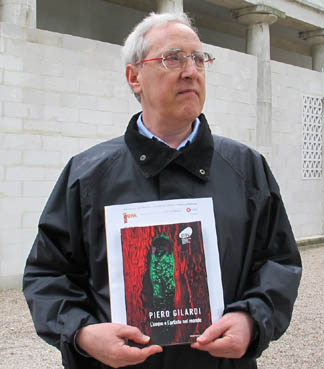
He is editorial director of Juliet art magazine.






NO COMMENT